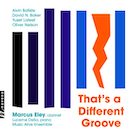

Marcus Eley: That's a Different Groove
Navona
Records
Writing about Marcus Eley's 2023 release Perseverance, Gramophone magazine's Patrick Rucker made note of “the extraordinary beauty of … Eley's clarinet, velvety throughout all of its registers, not to mention its immense expressivity.” Rucker's words apply equally well to the playing on That's a Different Groove, the focus this time on clarinet works by Alvin Batiste, David N. Baker, Yusef Lateef, and Oliver Nelson. Eley's front and centre throughout, with three of the pieces duets featuring him and pianist Lucerne DeSa, while Batiste's Tune Suite no. 1 partners Eley with the Music Alive Ensemble and others. Without sacrificing their jazz character, the four works are transformed in being reimagined for a chamber music context, hence the album title.
Groove's the unifying principle, of course, but rhythm here doesn't mean straight-up shuffle or swing rhythms but more an omnipresent sense of animation, urgency, and thrust. Or to put it slightly differently, the performances aren't static, even during those moments when they venture into adagio-like realms. Many of the reinventions are fascinating too, Lateef's reimagining of Brahms a case in point. To be precise, they're not jazz clarinet settings, though they are genre-crossing pieces for clarinet tinged with jazz feeling. As a clarinetist who graduated from the Indiana University School of Music, studied at Vienna's Hochschule fuer Musik und darstellende Kunst, and has appeared as a soloist with the Berlin Symphony Orchestra, Louisville Orchestra, and other ensembles, Eley certainly has the skills for the job.
The subtitle of Batiste's Tune Suite no. 1 (2000), Swing in the Abstract, could stand for the title of the album in general. In time-honoured jazz tradition, the single-movement piece features the clarinet as both as a front-liner and as a partner engaging in call-and-response with Music Alive Ensemble's four strings. Batiste was sometimes called a “New Orleans clarinetist,” and true to form traces of New Orleans and blues traditions emerge within this engaging classical-chamber setting. The inclusion of piano, bass, and drums in the arrangement adds significantly to the swing feel of the performance, and, truth be told, as prominently featured as Eley is in the performance, the fact that others figure as prominently makes Tune Suite more akin to a full-ensemble presentation than one pairing a soloist with supporting players.
Like Batiste's, Baker's Sonata for Clarinet and Piano (1986) draws from jazz and blues traditions, directly so in the opening “Blues” movement. Interestingly, Baker personifies the multiple genre bases covered by Eley's release in having been a Distinguished Professor of Music and Chairman of the Jazz Department at the Indiana University School of Music (he was also honoured three times by DownBeat and received in 2007 the Living Jazz Legend Award from the John F. Kennedy Center for the Performing Arts). Partnering with DeSa, Eley takes the lead forcefully on “Blues” and never relinquishes it thereafter—even if the pianist is a vital presence too. It's easy to find one's attention pulled away from the clarinet, for example, when DeSa delivers boogie-woogie and blues licks. The eloquent central movement, “Loneliness,” exudes all the sadness and solemnity one would expect (it also includes, however, impressively virtuosic runs by both players), while the vivacious “Dance” lives up to its title with calypso and Afro-Cuban moves and, again, dynamic performances from both players.
A name long familiar to jazz fans, Lateef developed proficiency on multiple instruments, from alto and tenor saxophones to flute, wind, string, and percussion instruments. He also acquired degrees from the Manhattan School of Music and in 2010 was awarded the Lifetime Jazz Master Fellowship from the National Endowment for the Arts. In his four-part Sonata for Clarinet and Piano (1998), Lateef re-imagines Brahms' Clarinet Sonata Opus 120 no. 2 in strikingly original fashion. Hewing to classical form, the opening “Allegro appassionato” paints with darker colours as Eley engages in conversational to-and-fro with DeSa. That sombre tone carries over into the “Andante un poco Adagio” before the “Allegretto grazioso” and “Vivace” movements inject the mercurial work with livelier, at times dance-related gestures.
While Nelson distinguished himself as an accomplished saxophonist and studied composition and theory at Washington University in St. Louis, he also, interestingly, studied piano, taxidermy, dermatology, and mortuary science and later wrote music for film and television projects in Los Angeles. Appearing here in a clarinet arrangement by Eley, Nelson's three-part setting Sonata for Alto Saxophone and Piano (1957) begins with a “Drammatico” movement that is undeniably dramatic in its theme and testimonies by Eley and DeSa but also affectingly lyrical. That elegiac character permeates the stately “Largo” that follows, its clarinet song rather Copland-esque in its quiet majesty. That Nelson would conclude the work with a spirited movement, aptly titled “with Vigor,” doesn't come as a complete surprise. The momentum generated by the movement's energized swing also neatly dovetails with the album theme.
As is always the case with projects such as these, the results flatter the performers as much as the composers. Eley's enthusiasm for the material comes through at every moment, which does much to make That's a Different Groove establish the strong impression it does and maintain its hold on the listener from start to finish.May 2025